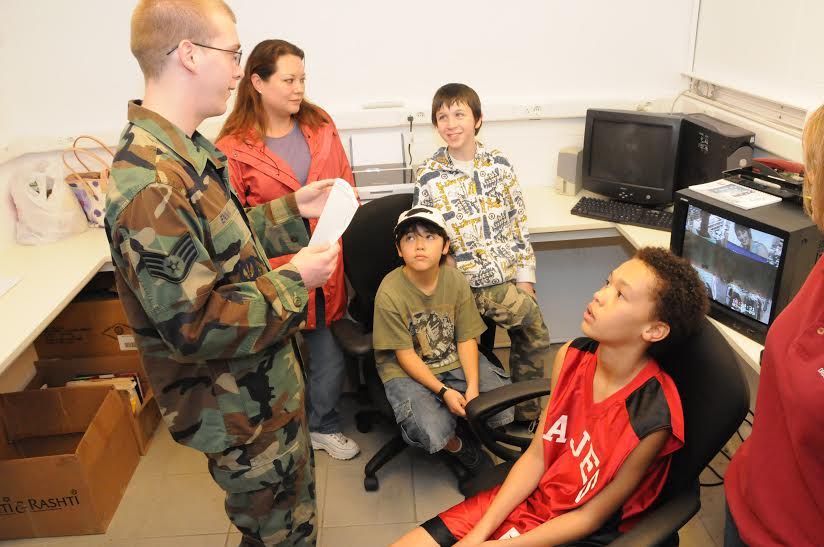Through his eyes: Non-traditional student uses age to further education
Shawn Ennis teaches children how to stay away from drugs during a deployment in Germany. Ennis taught kids how security systems work as in cameras and alarms, that way they knew they were protected.
November 12, 2014
As Shawn Ennis opens the Photoshop file on his computer, he grins, looks it over and gives a sarcastic chuckle to himself.
As confused as everyone else in the room, the 5-foot-10 student dons a disheveled beard — one that hasn’t been shaved in a few days — and a haircut that, at one time, looked to be a buzz cut, but has now grown into a more soft-looking ‘do.’ He turns to me after looking at a picture of the plastic car on his computer screen and asks, “Do you look at me any differently because I’m not as young as you?”
Ennis and I began talking about what it is like to be in a class full of 20 to 22 year olds and if he thought it was strange being there. As a 30-year-old veteran, non-traditional college student Ennis doesn’t have time to worry about prejudices against older, non-traditional students. He has his grades, a job and a family to keep up with.
“Most people don’t even know I’m 30 until it gets brought up,” Ennis says. “I’ve got this grungy look, so not many can tell the difference. When I shave and get a clean cut, I’ve been told I look 21 or 22.”
I spent a few days with Ennis — I learned his routine and lifestyle and how drastically different it was from mine, and most college students my age. His schedule varied from day to day, depending on what he did at school, home or work.
It’s now 2:10 p.m. on a Monday and the post-lunch drowsiness is setting in in a dimly-lit classroom. Ennis wheels his chair over to Trey Alessio, a junior in Ennis’ class — someone who is also struggling on the Photoshop assignment, to give him his two cents worth on where to head with the assignment.
To an innocent bystander, it’s just one student helping another. But Alessio says he sees Ennis a bit differently, not in a bad way, but as a figure who might have a little bit more real-world knowledge than he does.
Alessio often spends his Friday and Saturday nights out with friends. He enjoys some time off from the stresses of school and work — he’s a regular writer for the Iowa State Daily and radio host for KURE. Alessio runs on a fairly normal schedule: Wake up, class, work, extracurriculars and sleep, when he gets the chance.
It’s drastically different for Ennis. Some mornings start at 6 a.m. where he gets up early to play with his 2-year-old daughter, Ariadne. On other mornings, Shawn rises around 8:30 a.m. or, if he’s running late, 9 a.m. to get to class.
Alessio says sometimes students shy away from the non-traditional students, thinking they, personally, aren’t as knowledgeable or don’t have the same work ethic as the older students.
“It was nice to hear what [Shawn] was saying, though,” Trey says, speaking of Ennis’ beliefs in the classroom. “We’re on the same page and we kind of take life as it comes.”
Shawn has attended Iowa State for a little more than a year now and has gotten a pretty good idea of what the walls of Hamilton Hall can do to newer students.
“I see some younger people always freaking out [about] getting an internship and worrying about getting all the course credits in at once,” Ennis says as he makes a pumping motion with his hands. “I’d just say slow down…calm down and breathe.”
Ennis wheels away from Alessio and stops himself with his hands back at his computer. After fiddling with the pen tool on Photoshop for a while, he has traced the toy car and looks it over.
Then, glancing back to me asks, “Well, it’s not perfect. But I think it’s close, right?”







